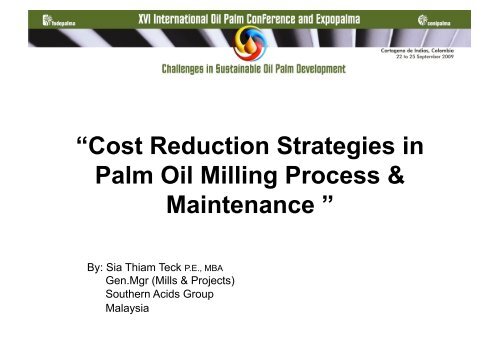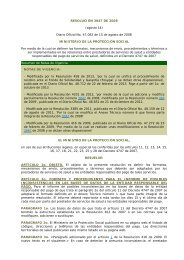“Cost Reduction Strategies in Palm Oil Milling Process ... - Fedepalma
“Cost Reduction Strategies in Palm Oil Milling Process ... - Fedepalma
“Cost Reduction Strategies in Palm Oil Milling Process ... - Fedepalma
You also want an ePaper? Increase the reach of your titles
YUMPU automatically turns print PDFs into web optimized ePapers that Google loves.
<strong>“Cost</strong> <strong>Reduction</strong> <strong>Strategies</strong> <strong>in</strong><br />
<strong>Palm</strong> <strong>Oil</strong> Mill<strong>in</strong>g <strong>Process</strong> &<br />
By: Sia Thiam Teck P.E., MBA<br />
Gen.Mgr (Mills & Projects)<br />
Southern Acids Group<br />
Malaysia<br />
Ma<strong>in</strong>tenance ”
Southern Acids Bhd (SAB) Group, Malaysia<br />
• Founded 1957 - small rubber estate<br />
• Now a fully-<strong>in</strong>tegrated company with:<br />
- OP plantations & mills <strong>in</strong> Malaysia & Indonesia<br />
- <strong>Palm</strong> <strong>Oil</strong> Ref<strong>in</strong>ery (1972)<br />
- Oleochemical Plant (1980)<br />
- Bulk Term<strong>in</strong>al handl<strong>in</strong>g PKE<br />
• Overseas markets <strong>in</strong> USA, Europe, Ch<strong>in</strong>a,<br />
Japan, Korea, Taiwan and Australia.
Outl<strong>in</strong>e of my Presentation<br />
1. Pros & cons of certa<strong>in</strong> Mill Mach<strong>in</strong>ery from<br />
po<strong>in</strong>t of view of an Operations Man<br />
2. Suggested improvements to mill<strong>in</strong>g process<br />
4. Discussion & Conclusion
mills. Wear and tear of cages is also <br />
significantly reduced. <br />
Grow<strong>in</strong>g popularity of FFB <br />
A. FFB Load<strong>in</strong>g Ramp/Marshall<strong>in</strong>g Yard<br />
transport conveyors ‐ fruit spillage <br />
A1. Cages >10 t & Cage Indexers<br />
is significantly reduced. <br />
A2. Cage wear & tear significantly reduced<br />
A3. Safety – no more wirerope accidents<br />
A4. FFB Transfer/Load<strong>in</strong>g conveyors:<br />
• Labour sav<strong>in</strong>gs, m<strong>in</strong>imal fruit spillage<br />
• “Ideal” cha<strong>in</strong> conveyor length?
A Well-designed FFB Conveyor System <strong>in</strong> Malaysia
allow<strong>in</strong>g the use of a smaller‐pitch <br />
cha<strong>in</strong>. <br />
The work<strong>in</strong>g load sets a lower limit <br />
on pitch, and the speed sets an <br />
A5. Conveyor cha<strong>in</strong> sprockets – guidel<strong>in</strong>es<br />
upper limit (I personally would <br />
• As big as possible given the application<br />
keep conveyor cha<strong>in</strong> speeds below <br />
• Cha<strong>in</strong> pitch vs. work<strong>in</strong>g load<br />
• Cha<strong>in</strong> pitch vs. cha<strong>in</strong> speed<br />
1 m/s) <br />
• Recommended cha<strong>in</strong> for Mills < 1 m/s<br />
• Dummy driven sprockets<br />
The smaller the pitch, the less the <br />
noise, wear and mechanical losses.
Which conveyor will run smoother?
Use of dummy driven sprockets <br />
especially where long runs of cha<strong>in</strong> <br />
conveyors cannot be avoided, is <br />
known to prolong cha<strong>in</strong> life. <br />
Dummy sprocket at “work”<br />
Dummy sprocket at rest
An example of splitt<strong>in</strong>g a long conveyor<br />
<strong>in</strong>to short manageable sections
use, though tradiIonal Horizontal <br />
Sterilizers (HS) are sIll the most <br />
popular. Many millers are sIll wary <br />
of the claims of higher OER and <br />
B. Sterilization<br />
lower runn<strong>in</strong>g cost of the CVS. <br />
B1. Increas<strong>in</strong>g use of Cont<strong>in</strong>uous & Vertical Sterilizers (CVS)<br />
B2. Claims of higher OER & lower runn<strong>in</strong>g cost of CVS<br />
B3. Tilt<strong>in</strong>g Sterilizer (TS) – best of both worlds?
A modified Vertical Sterilizer <strong>in</strong> Malaysia
advantages of both CVS and HS <br />
systems, the TilIng Sterilizer (TS) is <strong>in</strong> <br />
my op<strong>in</strong>ion, the most user friendly as <br />
the design lends itself to ease of steam <br />
penetraIon and opImal uIlizaIon of <br />
space conta<strong>in</strong>ed with<strong>in</strong> the vessel. <br />
Tilt<strong>in</strong>g Steriliser <strong>in</strong> Horizontal Position
Tilt<strong>in</strong>g Sterilizer <strong>in</strong><br />
Incl<strong>in</strong>ed Position
<strong>in</strong> press fibre. <br />
For ease of ma<strong>in</strong>tenance of the <br />
Press, the Digester should be offset <br />
or posiIoned away from the <br />
C. Press<strong>in</strong>g<br />
centre‐l<strong>in</strong>e of the Press. <br />
C1. Press capacity: P15 or P20 or P25?<br />
Re‐<strong>in</strong>troducIon of heat <strong>in</strong>sulaIon <br />
C2. Press ma<strong>in</strong>tenance - position<strong>in</strong>g of Digester vs. Press<br />
layer Crude <strong>Oil</strong> Tank and associated <br />
C3. Re-<strong>in</strong>troduce heat <strong>in</strong>sulation at Crude <strong>Oil</strong> Tank<br />
pip<strong>in</strong>g to m<strong>in</strong>imize downstream re‐<br />
C4. Re-<strong>in</strong>troduce Rotor pump for crude oil transfer?<br />
heaIng which can lead to oil <br />
emulsificaIon.
Nozzle Bowl Centrifuge – some mills <br />
claim that certa<strong>in</strong> high capacity <br />
centrifuge designs cannot handle <br />
sludge with oil content > 12%. <br />
D. Clarification<br />
Gravity flow of oil/sludge as far as <br />
possible – higher risk of oil <br />
D1. Siz<strong>in</strong>g up Vertical Clarifier Tank – bypass <strong>Oil</strong> Purifier<br />
emulsificaIon when there is excessive <br />
D2. Drawback of 12 nozzle 8 tph Sludge Centrifuge<br />
- cannot handle sludge with oil content > 12%<br />
pump<strong>in</strong>g especially with centrifugal <br />
pumps. <br />
D3. Gravity flow of oil/sludge as far as possible<br />
– reduced risk of oil emulsification
Claybath or Hydrocyclone due to lower <br />
wear‐and‐tear rate (no pump <br />
<strong>in</strong>volved!) <br />
Whole <strong>in</strong>dustry as a whole should <br />
E. Kernel Recovery Station<br />
work towards lower<strong>in</strong>g markeIng <br />
specificaIon of Dirt <strong>in</strong> Kernel to <br />
E1. Re<strong>in</strong>troduce Nut Dry<strong>in</strong>g/Cool<strong>in</strong>g<br />
– higher Nut Crack<strong>in</strong>g Efficiency & Kernel Ext Rate<br />
facilitate the entry of its downstream <br />
E2. Use of Paddlewheel-type Claybath Separator<br />
- lower wear-and-tear (no pump!)<br />
byproduct PKE <strong>in</strong>to a potenIally new <br />
big market – poultry feed. <br />
E3. Use of Shaftless Nut Polish<strong>in</strong>g Drum<br />
- lower <strong>in</strong>cidence of downtime due to shaft breakage<br />
E4. Lower<strong>in</strong>g quality specification of Dirt <strong>in</strong> Kernel<br />
- a potentially new big market: poultry feed.
Cu>ers followed by Presses to prepare <br />
and condiIon the EFB for fuel<strong>in</strong>g the <br />
boiler <br />
Upgrade to boilers with taller furnaces <br />
and which are also equipped with <br />
F. Power Station<br />
mov<strong>in</strong>g grate to allow for 25% mix<strong>in</strong>g <br />
F1. Use of EFB Shredders/Cutters followed by Press<strong>in</strong>g<br />
– supplementary fuel for boiler<br />
of resulIng EFB fibre with <br />
F2. Upgrade of boilers (taller furnaces + mov<strong>in</strong>g grate)<br />
- 25% mix<strong>in</strong>g <strong>in</strong>to conventional boiler fuel<br />
convenIonal process fibre, as boiler <br />
fuel. <br />
F3. Boiler Ma<strong>in</strong>tenance<br />
- Automatic Blowdown Systems<br />
- Quarterly/Half-yearly waterside <strong>in</strong>spection
Indonesia, is probably not be<strong>in</strong>g <br />
treated with respect by many mill <br />
eng<strong>in</strong>eers. The failure to provide <br />
adequate space for sludge dry<strong>in</strong>g beds <br />
or the absence of con5nuous de‐<br />
G. Effluent Treatment<br />
sludg<strong>in</strong>g very o`en results <strong>in</strong> loss of <br />
G1. Cont<strong>in</strong>uous de-sludg<strong>in</strong>g of Anaerobic Ponds<br />
retenIon Ime and digesIon efficiency, <br />
G2. Provision of space for Sludge Dry<strong>in</strong>g Beds<br />
lead<strong>in</strong>g to a deterioraIon <strong>in</strong> quality of <br />
G3. Zero Discharge – utilization for BioCompost<strong>in</strong>g Plant<br />
the f<strong>in</strong>al discharge. <br />
G4. In-situ Desludg<strong>in</strong>g – yet to be conclusively proven?
from a poorly run greas<strong>in</strong>g or <br />
lubricaIon program. And <strong>in</strong>variably, <br />
the primary cause is the <strong>in</strong>adequate <br />
a>enIon given to this important <br />
aspect of PrevenIve / Scheduled <br />
H. Conclud<strong>in</strong>g Remarks<br />
Ma<strong>in</strong>tenance. Is it not Ime for us to <br />
upli` the status of the <strong>Oil</strong>y Man ? <br />
H1. Inadequate focus on Lubrication / <strong>Oil</strong>y Man?<br />
H2. High crop season: Mill runs 24 hrs, FFB evacuation<br />
from estate?
<strong>in</strong>volv<strong>in</strong>g methane emission avoidance <br />
or reducIon through the uIlizaIon of <br />
POME for the Fibre ComposIng <br />
process, with or without carbon credit. <br />
Another opIon is captur<strong>in</strong>g methane/<br />
H. Conclud<strong>in</strong>g Remarks (cont’d)<br />
biogas for uIlizaIon <strong>in</strong> gas eng<strong>in</strong>es to <br />
produce green electricity. <br />
H3. Is cost everyth<strong>in</strong>g?<br />
- Corporate Social Responsibility (CSR)<br />
Unfortunately, such environment‐<br />
- Carbon Footpr<strong>in</strong>t<br />
- reduce/avoid methane emission – Biocompost<strong>in</strong>g Plant<br />
- trap & utilize biogas – electricity generation<br />
friendly techniques has been rather <br />
slow <strong>in</strong> com<strong>in</strong>g ‐ out of the 400+ mills <br />
<strong>in</strong> Malaysia, only 4% has started <br />
captur<strong>in</strong>g methane from the POME
Settl<strong>in</strong>g Pond of a well-run Effluent Plant <strong>in</strong> Indonesia
MUCHO GRACIAS






